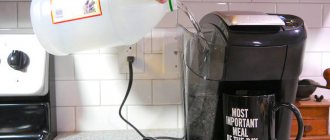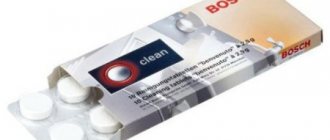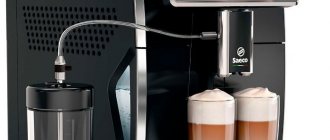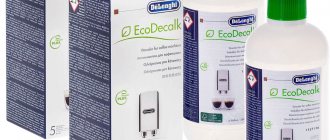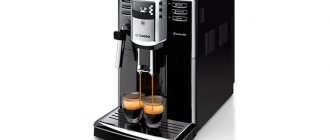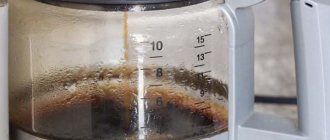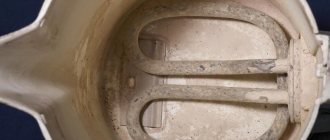Descaling your coffee machine with citric acid
Many coffee lovers cannot imagine their life without tasty and noble coffee. A considerable number of them are accustomed to preparing their favorite drink in a coffee machine. But this device, like all others, gets dirty over time and needs to be cleaned. By the way, the main problem with coffee machines is scale. To return the parts of the coffee machine to their original appearance, we suggest you use the good old remedy – citric acid.
Why descale?
It is no secret that water contains various compounds (potassium and chloride - this is not a complete list). When heated, they form a limescale deposit that gets into your cup along with the coffee, making it unpalatable. But this is not the main danger. The fact is that scale in large quantities can lead to corrosion of the internal elements of the coffee machine. You should know that the surface of plaque is porous, so new life can very easily arise in it, which will be accompanied by active growth and development of microorganisms.
Good to know: the bulk of plaque is formed by calcium dissolved in water. That is why the process of cleaning devices from scale is usually called decalcification.
How do you know when it's time to clean your coffee machine?
The following “symptoms” may indicate that your coffee equipment needs decalcification:
- the smell of coffee has become unpleasant and musty;
- coffee is undercooked or not strong enough;
- steam pressure decreased significantly;
- you hear unusual sounds that the coffee machine makes while preparing your favorite drink.
Please note: many modern coffee machines (with above-average price tags) have special sensors for automatic limescale checking. A red indicator or corresponding message on the screen will warn the owner that the equipment needs decalcification.
Why should you clean your device with citric acid?
Almost all coffee machine manufacturers whose products are presented on the modern market produce their own cleaning products for coffee machines. There are special products for cleaning cars from leading manufacturers. You will also find formulations on sale in various forms - tablets, liquids, and so on.
Important: we do not recommend that you use universal products. After all, they can lead to damage to the inner surface of parts. Also, never use any scale cleaner in the bathroom or kitchen. They can lead to serious problems. The same applies to kitchen detergents.
We can safely say that the best universal product suitable for cleaning a car is none other than citric acid. And that's why:
- citric acid is absolutely safe and harmless to humans;
- effectively copes even with difficult-to-remove scale;
- citric acid is not endowed with the ability to release toxic substances during heating;
- is a very budget-friendly product, so buying a good old “lemon” will cost you significantly less than an advertised branded coffee machine cleaner;
- always available in stores (both grocery and hardware stores).
Observe the proportions: prepare a solution of citric acid
In order to prepare a highly effective lemon solution, you need to take 25-30 g of powder per liter of water. That is, you will need to use either three small bags (each containing 10 g of powder), or 1 large bag per 25 g.
By the way, don't forget to read the instructions. After all, the amount of water for individual coffee machines may be different. Be sure to clarify this nuance.
Important: calculating each gram of citric acid is not at all necessary. However, do not overdo it with adding powder. Many people naively believe that the more citric acid you add to the water, the better. But in reality this is not at all the case. After all, an overly concentrated, active solution may well become the culprit of damage to the internal elements of the coffee machine.
How to clean a coffee machine using citric acid
The average duration of the coffee machine decalcification process is 30-45 minutes. If there are old scale deposits inside the device, then it is likely that you will have to start the cleaning process of your favorite assistant not once, but several times.
Step-by-step cleaning instructions:
- First, you need to unplug the coffee machine from the network.
- Then take out the water container and rinse it under a strong stream. After this, pour an aqueous solution of citric acid inside (see the user manual for the amount of liquid required for the decalcification process).
- Place the water container in the device and turn it on.
- If your device has a function for automatically descaling the coffee machine, all you have to do is turn on the appropriate program. To find out how to do this correctly, look at the instructions. If you do not have such a function: wait 15-20 minutes and start the coffee preparation process without adding raw materials. Repeat this process as needed until you have used up the entire supply of citric acid solution.
- Now you need to turn off the coffee machine. Remove and rinse the water container under a large stream of water.
- Now let's move on to washing. Fill the tank with the maximum volume of clean water and turn on the drink preparation mode. Repeat the process until you have used up all the water. It is recommended to repeat this step again (remembering to rinse the liquid container).
Thus, with the help of citric acid and cleaning the inside of the coffee machine, as well as two rinses, your assistant will be ready for further service.
It is important to remember: the coffee machine should be cleaned once every quarter or every 250 cups of coffee. But at the same time, you need to focus on the hardness of the water you use to prepare the drink. It's no secret that if you fill with distilled liquid, your equipment will need cleaning much less often.
Now let's draw conclusions:
- citric acid does an excellent job of removing scale;
- when using citric acid, you pay much less, but get excellent results (no worse than from professional products);
- citric acid is not capable of corroding the internal parts of the equipment, therefore it is suitable for cleaning and decalcification, regardless of the brand or coolness of your coffee machine.
Descaling your coffee machine with citric acid
Number of votes: 264 3
5
1
264
Was the information helpful? Rate and leave a comment? Better yet, share!
Maxim October 14, 2021, 10:41 pm
Thanks for this tip. Really helped, Bosh Tassimo coffee machine
Comments
We will be glad if you share your opinion or add to a note or article.
What are the advantages and disadvantages of a capsule coffee machine?
When choosing a Dolce Gusto , you will not have to study the operating instructions for a long time, because the preparation and operation process is as simple as possible. The coffee included is high quality and delicious.
Advantages:
- ease of use;
- a wide variety of drinks;
- unusual appearance;
- low cost;
- ease of care.
Flaws:
- a short cord, which means the device must be located near an outlet;
- impossibility of using coffee capsules from other companies.
Despite some shortcomings, we recommend purchasing a Dolce Gusto coffee machine. After all, you will have the opportunity to enjoy drinks at home that you could previously only drink in a cafe.
Material on the topic: Coffee with different types of syrups
Features of the Dolce Gusto capsule machine
The Dolce series of coffee machines became sales leaders several years ago, captivating consumers with their functionality. Such devices differ from their competitors in their unusual design. The creators tried to show that coffee drinks can be not only tasty, but also beautiful.
The Dolce coffee machine uses special capsules in its operation. This is precisely the main difference between a capsule coffee maker. It is loaded not with ground coffee, but with small tablets in which the consumables are hermetically sealed. In a coffee machine, the capsule is pierced with a special needle, and water and steam are passed through the pressed raw materials. It makes an excellent drink.
It is enough to wash the coffee machine once a week. Once every 3-4 months, it is recommended to carry out a complete cleaning using citric acid or a special product. The design of Dolce Gusto coffee machines will decorate any kitchen.
Professional and folk remedies for cleaning coffee makers
Coffee machine manufacturers have long created a separate source of income for themselves: they produce and sell products for descaling devices. The latest generation models have an auto-cleaning function with the obligatory use of a proprietary product. After brewing 200-300 cups of coffee, the smart unit signals that it's time to clean. Professional products are produced in the form of tablets, powders and liquids.
Each coffee machine manufacturer claims that only branded products can be used. This is nothing more than a marketing ploy. If you read the ingredients on the label, it becomes clear that the main component is citric acid. Is it worth spending a lot of money (from 1000 to 1200 rubles) on purchasing a branded product when a packet of citric acid costs several times less and is sold in any grocery store?
Using food-grade citric acid to descale a coffee maker has a number of advantages:
- citric acid does not cause environmental pollution and does not release toxins;
- the process of dissolving limescale formations occurs gently, without releasing hazardous chemicals harmful to health;
- To dissolve even long-standing formations, you need a small amount of acid in the form of crystalline powder (30 g per 1 liter of water).
Instructions for descaling different types of coffee makers
The method for descaling a coffee maker depends on the design of the device. Machines with a removable filter and brewing unit can be easily washed under the tap in running water. If you regularly wash the device after making coffee, then thorough cleaning with citric acid or store-bought tablets can be done no more than once a month.
Models with a built-in unit often have an auto-cleaning (decalcification) function, and if it is not provided, the scale is removed independently using a cleaning solution.
Most modern products are based on citric acid.
Descaling a drip coffee maker
- Wash the filter with warm water and a soft brush (unnecessary toothbrush) and return it to its place.
- Prepare a working liquid from citric acid: dissolve 30 g of crystalline powder in 4 glasses of warm water.
- Pour the solution into the water tank. Add cold water to the tank up to the Max mark.
- Turn on the coffee maker for 5-10 minutes. After 30 minutes, repeat the procedure and wait until the entire solution passes into the receiving flask.
- If there are still traces of scale on the filter, dip it in a hot solution prepared in the indicated way and hold for an hour.
- Rinse the filter well and replace it.
- Run clean water through the coffee maker several times until the acid comes out completely.
Citric acid can be replaced with vinegar. To do this, use white table vinegar with a strength of 9%, dissolved in water in a ratio of 1:2.
If the glass vessel for collecting the finished coffee becomes cloudy, you need to fill it with a warm solution and rinse thoroughly after 30 minutes with water.
Descaling carob, pod and capsule coffee makers
The operating principle of these types of coffee makers is almost the same, the only difference is in the design of the receiving device for coffee powder. Therefore, the descaling methods are the same:
- Unplug the coffee maker.
- Remove used coffee from the horn (holder).
- Wash the removable reservoir under running water and fill it with a solution of the product prepared according to the manufacturer’s instructions, or a solution of citric acid (according to the recipe described above). Allow the working solution to act for 15–20 minutes.
- Empty the pulp container.
- Empty the water from the drip tray.
- Turn on the coffee maker.
- Release approximately half of the heated solution through the cappuccino maker nozzle, turning on the steam mode.
- Pass the remaining solution through the empty horn (capsule holder) in the coffee preparation mode.
After removing the limescale, they begin to wash the inner surface of the coffee maker; the process consists of two cycles.
Rinse cycle for loading block and heater:
- fill the tank with clean water (up to the Max mark);
- start the coffee preparation program;
- Collect the rinsing water in a waste container.
Cappuccino maker rinse cycle:
- Fill the tank again with clean water (up to the Max mark);
- select and run the steam generation program. Collect the rinsing water from the cappuccino maker nozzle into a nearby container.
Perform each cycle twice.

